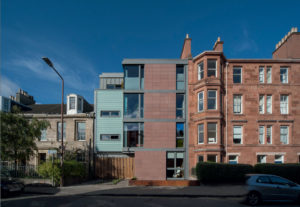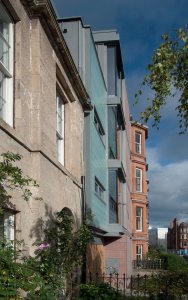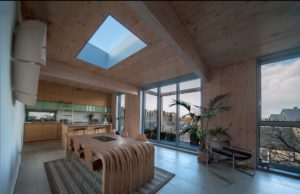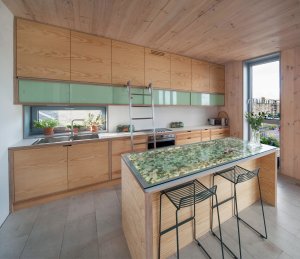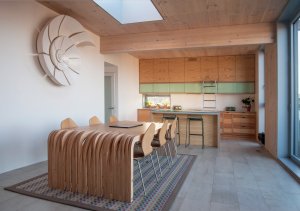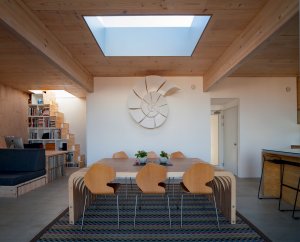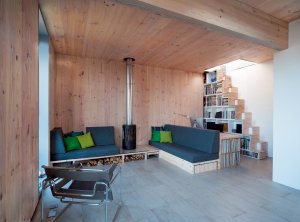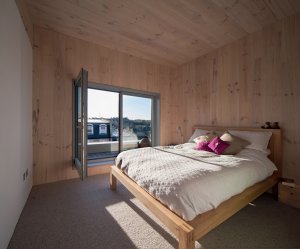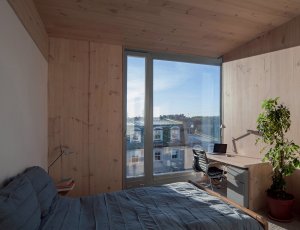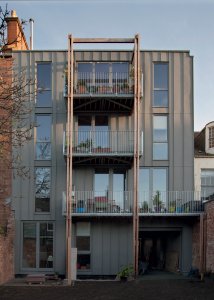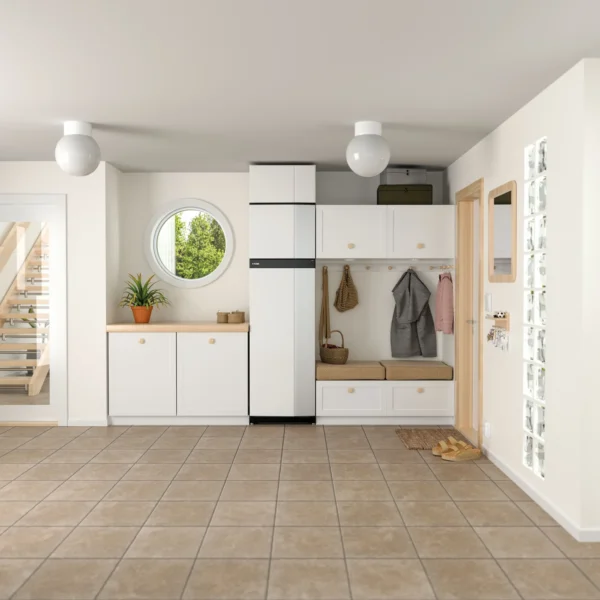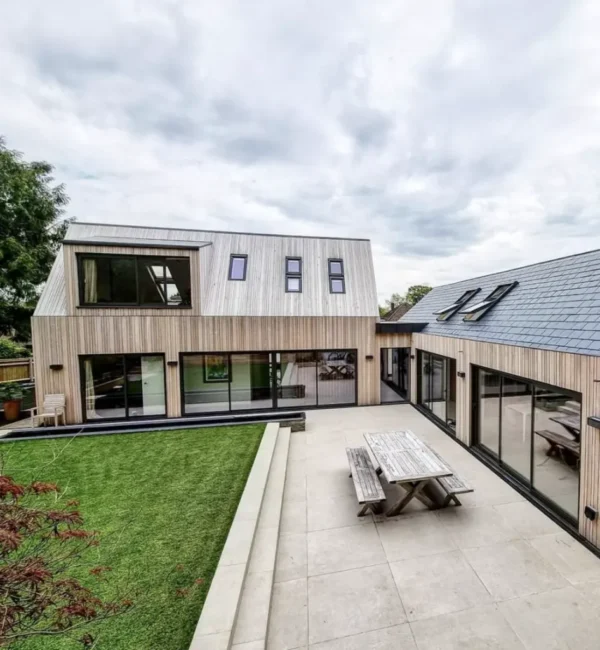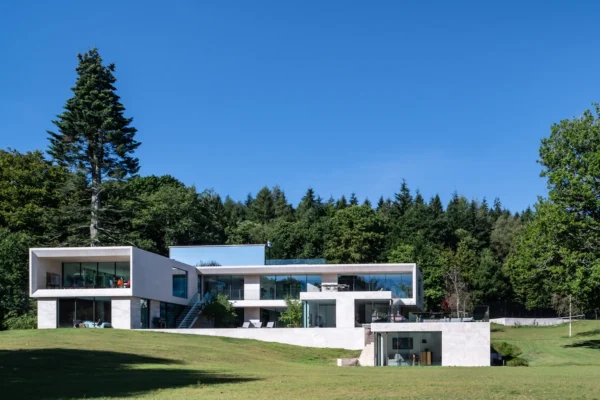Innovative Community Custom Build in Edinburgh
Architect John Kinsley’s lightbulb moment was sparked by reading a magazine article. “The piece was all about the merits of community projects in South America, where one in four new homes is created this way,” says John, who credits the article for his decision to collectively buy a plot of land and construct a block of four tenement flats in Edinburgh, along with a group of complete strangers.
“The UK house building market is almost completely dominated by a handful of big companies,” he continues. “Our method had the potential to eliminate the developer’s profit, so we could build at cost – around 20% less. I was also interested in how the typical Scottish model of shared tenement living could be updated for the 21st century, particularly in terms of sustainability.”
Finding land
John and his wife Jenny, a garden designer, knew of the perfect site in Edinburgh’s seaside suburb of Portobello, just a street away from their current three-bedroom Georgian house. The vacant 400m2 lot formerly hosted a cinema, which had been knocked down 15 years earlier. A handshake agreement was struck with the owner to buy the site for £250,000, dependant on obtaining planning consent.
The couple advertised their community build on a local website. This led to an evening presentation to 18 people in a nearby cafe where John pitched his vision, detailing the costs and an estimated time frame. “Over the next few months our ideas developed and the numbers condensed to a group of committed people,” he says.
- Names John & Jennifer Kinsley
- LocationEdinburgh
- Type of projectCommunity self-build
- StyleContemporary
- Construction methodCross-laminated timber frame
- Project routeArchitect & main contractor
- Plot size400m2
- Land cost£250,000 (bought June 2015)
- House size110m2 (entire development is 498m2)
- Project cost £267,948 for the flat (£883,197 for entire development)
- Project cost per m2£2,436 for the flat (£1,773 for entire development)
- Construction time 40 weeks
- Current value£480,000 (£1.5m for entire development)
“I think there’s a perception of a community-led scheme being a hippy thing, but it’s important to understand that we’re not talking about communal living,” says Jenny. “This is completely different. Although ownership of our scheme is still collective just now, the intention has always been to transfer the flats out as individual properties as soon as is feasible. So if someone decided to put their flat on the market, it would be just like any other sale.”
Finance & funding
The trickiest part of the project proved to be establishing the most suitable financial setup. “This was new territory for the lawyers and accountants,” says John. “In the early days we spent a lot of time working out how to constitute ourselves as a singular entity in
order to obtain funding. We chatted to potential backers, lawyers and accountants to find out what setup they’d prefer.”
The best model was to form a limited company, so Bath Street Collective Custom Build (BCCB) was born, with four shares and four directors (one for each flat). “The company effectively became the client,” says John. “BCCB borrowed money from Ecology Building Society, paid the contractor and employed me as architect.”
“With John taking care of the design, it made sense for me to be a director and client,” says Jenny. “While it was a very steep learning curve, I suspect it was a lot easier doing everything as a group – if we had a problem then we were able to brainstorm it together.”
Time was also well spent writing the articles of association and anticipating various disaster scenarios. “We had a builder colleague keen to take one of the apartments, but he pulled out in spring 2015,” says John.
“Fortunately, he was immediately replaced by a local family. They took over the interest not only in his two-bedroom flat, but also in the adjacent one-bedroom apartment, which was still spare at that stage. After a quick redesign of these spaces into one large four-bedroom property, we had a full quota again.”
The site already had planning approval for six flats, so gaining consent for their community scheme was straightforward – taking just two months. “The planners liked our contemporary design,”says John.
Read more: How to get the planners on your side
“We spent a lot of time rounding up backing from friends and neighbours. In the end we had 20 letters of support and five letters of objection, which were mainly to do with overlooking issues involving the houses at the back. If you get too many objections the application is likely to go to planning committee, so it’s worth investing effort to get people on board from the start.”
Collective build
With consent in the bag, HM Raitt & Sons – a local family business – was engaged as the main contractor, on a total budget of £883,000 (including a tight 5% contingency, which was spent) to construct the whole block.
One of the key decisions was to use cross-laminated timber (CLT) for the wall and roof panels. The innovative system allows for ultra-strong sections of up to 13.5m by 3m. These are craned into place on site and screwed together with metal brackets.
Source it: Find the right structural system for your project
The build developed on a shell and core concept, whereby the main contractor first completed the external load bearing walls and internal stair. This left each family with a large open-plan space, allowing them to create their own bespoke flat layout by inserting stud walls where required before kitting it out as they saw fit.
“The idea was for everyone to buy their own kitchen and bathroom, and then pay the builder individually to install it for them,” says John. The Kinsleys, who secured the top floor flat, decided to tackle some of the works themselves. This included painting their new home’s interiors, as well as designing and building most of the furniture from birch plywood.
John hadn’t used cross-laminated timber as the superstructure for any of his previous architectural projects. “We were going to be working on a site wedged in a tight spot between a traditional tenement building and a two-and-a-half storey house,” he says.
“The panels are all prefabricated to a precise size and my biggest worry was whether I’d got the dimensions wrong. I had a couple of sleepless nights about it beforehand.”
The main advantages of CLT lie in the speed and accuracy of construction, which help to ensure predictable build costs. The prefabricated panels were from Egoin, a company based in Spain’s Basque region, and were shipped over using four enormous lorries. On site, three Spanish joiners used a huge crane to install the units.
“The Egoin joiners were highly organised and the main frame and roof for the block went up in just nine days,” says John. “It was straightforward but quite a spectacle; passers-by and schoolchildren were lined up on the street to watch the crane in action. Seeing the shell of our new homes go up was exciting and emotional.”
Structural issues
The build phase wasn’t without its issues, however. “We discovered that the gable wall of the neighbouring house was shot to pieces,” says John. “The chemicals from the chimney smoke had reacted with the salty sea air and eroded the stone between the flue and the walls. You could literally push holes through it. In the end we had to rebuild a third of the gable wall and chimney, which caused delays to our project programme from the start.”
Another unforeseen issue was that the site consisted of made ground (artificially filled land). This included a number of soft spots, which meant the team had to switch to using expensive pile foundations. “Sorting this out pushed our timeslot for the CLT panels back by four months – not helped by the fact that Spain takes the whole of August off – and cost an extra £30,000.”
The timing of Brexit also proved a bombshell. “With the pound dropping, we dodged a massive bullet with the CLT panels,” says John. “Thankfully Egoin had quoted us in pounds and stood by the price.” They were not so lucky with the German windows, which were priced in euros. The helpful UK rep suggested alternative products that minimised the damage.
“I think for the other three families involved, it was a significant reassuring factor to know I was investing in it, too. If something went wrong or it costed more than expected, then I was sharing the pain. It was in my interests to go the extra mile to solve problems,” says John.
Jenny adds that everyone wanted the scheme to succeed. “We all worked hard to get along and we became stronger as a group as the project progressed,” she says.
Another potential stumbling block that was identified early on was how to satisfy Scotland’s sound performance regulations on a multi-storey build. Employing an acoustic consultant during the process was valuable in finding the right solutions. John also engaged a fire engineer to provide reassurance on that score.
Modern living
The end result has proved well worth the challenges. John and Jenny’s top floor three-bedroom flat feels bright and spacious with an open-plan living, dining and kitchen area that offers fabulous sea views. A workstation behind the sofa includes a clever alternating tread staircase, which leads up through a sliding overhead window to the roof garden above, and also doubles as a bookcase.
The internal surface of the CLT panels has been left exposed, providing a contrast with the white stud walls. The apartment achieves Passivhaus standards of insulation and airtightness, and is fitted with a mechanical heat recovery ventilation system. The vents are hidden in hall and bathroom bulkheads to achieve clean, uninterrupted wooden ceilings.
Power is generated from solar photovoltaic panels and suppliers that provide 100% renewable energy – so the building is completely fossil fuel free. “After living in traditional tenements and then a cold draughty Georgian house, being in a well-insulated, airtight home is fantastic,” says John.
Jenny agrees: “The lovely thing is that we get the advantages of a tenement with high ceilings, big windows and lots of daylight – but no drafts. There is no central heating because we don’t need it.”
The kitchen’s centrepiece is the unusual glass island worktop filled with local sea glass. “We debated using metal and Corian before Jenny came up with this idea,” says John. The couple spent months collecting the material along 20 miles of East Lothian coastline, from Portobello to North Berwick.
“In the end we didn’t have enough, so I Facebooked people,” says Jenny. “We have sea glass sent from friends in Cornwall, Rome and my sister in New Orleans. It was fun to do and it looks really special.” The worktop is backlit with LED panels.
For the exterior, materials were chosen that would weather well and offer long-term low maintenance. The flats are clad in red sandstone, translucent Reglit glass panelling and French zinc.
“At the front of the building, we were constrained to a degree by what the planners would sign off. We wanted to be contextual and be good neighbours; we didn’t want to do anything too outrageous,” says John. “The zinc was another material that fell foul of Brexit. The original installer doubled the price, so we switched to someone I’d worked with previously, who was fantastic”.
Housing innovation
Bath Street Collective Custom Build has attracted plenty of political interest. “In Germany 60% of development is self-build, but in the UK the figure is just 2%. We need to tackle the issue of how difficult it is to buy land,” says John.
“Perhaps councils could give community groups first dibs before plots go on the open market. Or part of planning approvals for the big housebuilders, such as Taylor Wimpey, could be that a percentage of land should be made available for community schemes.”
Incidentally, in south west England, Teignbridge council has recently adopted a similar idea. The local authority requires that 5% of all development must be allocated to self and custom build.
“There are real advantages to taking the community-led route compared to buying a mass housebuilder type home,” says John.
“Firstly it’s cheaper, as there’s no developer taking a profit. Secondly it’s totally bespoke, and thirdly you can get to know the neighbours – so it’s a social thing. The owner is also investing in the community more, whereas a developer walks away at the end of the day.”
“It’s like having a tailor made suit without having to pay a fortune for the privilege,” says Jenny. “We’d definitely do it again”.
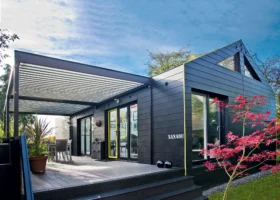
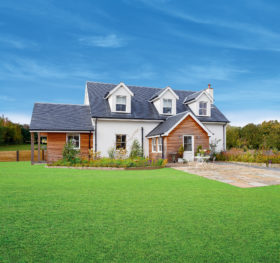






























































































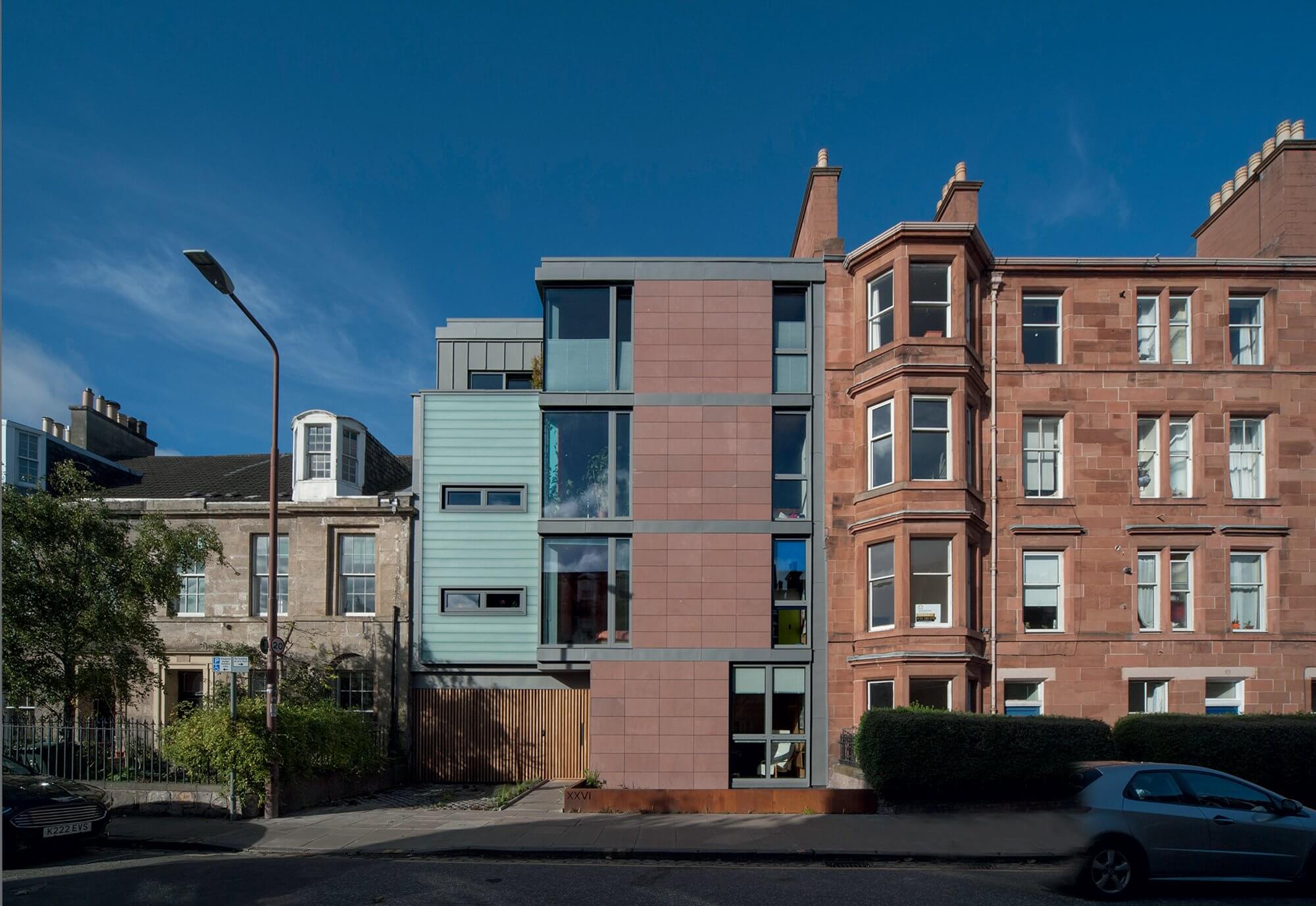
 Login/register to save Article for later
Login/register to save Article for later
